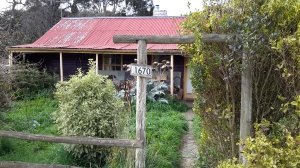Suddenly, I was on the outskirts of the tiny town of Bushy Park and hop fields began to edge the road. In case you don’t know, hops are the raw material for beer so the agricultural activity in this area is serious business. In Tasmania we have two mainstream brewers; the Cascade and Boags breweries plus other interesting boutique beer makers.
The Beer Pilgrim has lots of photographic information to offer. An ABC news item includes photos of the hops and some processes. In addition, information about the growing patterns of hops, their harvests and other details are located at Hop Products Australia abbreviated to HPA. I was fascinated when I read ‘The hop plant originated in China, but it was the Germans – way back in the 11th century – who first discovered the crop’s potential as an ingredient for beer, and they’ve been at it ever since.’ I wondered whether the world would be a different place if the Chinese had made that discovery first. What would be the Chinese equivalent of an Oktoberfest?
When I read the sign in the photo above, I felt good that I hadn’t found a way to walk on the river edge on the other side of these hop fields – if I had, then the soles of my shoes might have delivered exotic seeds or destructive pests to the ground.
As I continued walking, I enjoyed looking at properties and different vintages of houses.
The hop vines were not yet growing up the lines so the views across the paddocks were relatively uninterrupted. Before long, across a hop field I could see specialised hop buildings near private houses.
Then, as I reached 1 Acre Lane, at the far end I could see Oast Houses and other large buildings. In the Google Map photo below the hops have grown up the vines on the left and they obliterate the views I had over the empty paddocks – but this is the lane if you are visiting Bushy Park and looking for what I could see. On the street view of Google maps no sign naming the lane is in evidence, but since that street view was made a sign has been attached to a pole on the non-lane side of the road.
My feet were aching and touchy at each step. I wondered whether I had it in me to walk down the lane to see whether there was public access and have a look around, and then have the feet to walk back to the road. I still had quite a few kilometres to go to reach my day’s destination at Gretna and I felt rationing my steps could be a good idea.
Just then an old woman, on the main road, was dragging two large empty rubbish wheelie bins towards me and the lane. A tiny lady, I felt she could have fitted inside one of these. It looked like a massive effort for her. She was pleased to rest and chat with me. I asked if public access was available and she told me that I could look around the buildings but not in them, and that most were heritage buildings and no longer operational. She headed off down that very lane. That long lane. After she had taken a few steps she stopped for a rest. I realised this was a weekly challenge for her after the rubbish had been collected. I had no idea how far she had to walk with the bins, and since I could not see any residential houses I guessed that somewhere at the end of the lane in the precinct with the Oast Houses and other specialist hop buildings, she had a house. I called out ‘Can I give you a hand and take one of them?’ She didn’t have the energy to look grateful and simply said, ‘Yes’.
With apologies to The Beatles – The long and straightened road / That leads to her door / Will never disappear / I have not seen the road before / It will always lead me there / Lead me to her door













A very interesting post. I have heard about hops being made in beer making, and this has shown how little I knew about hops. Looking at the ABC news link pictures, I did not even know what hops look like, and I find the trellis type lines where the hops grow skyward very fascinating. Growing hops must be very labour intensive.
Thanks for sharing! 🙂
~Carl~
LikeLike
Like you, I knew nothing about hops except that that they were grown in the Derwent Valley and made into beer locally – and some tonnes are exported as well. That’s what I like about this walk – it introduces me to new information that is generated so close to my own door step. It reminds me how important it is to be a tourist in your own patch. And back to your comment – I was so busy looking at the empty lines that I didn’t think about what happens at harvesting time. Trillions of these little hop flowers must be picked each year.
LikeLiked by 1 person
Absolutely amazing. Your walk is an incredible endeavour. You would tune in to your surroundings much more than the majority of people. Love this, “A tourist in your own patch”. 🙂
LikeLike
I have been enjoying the reliving of the experience as I write each blog post. Double the pleasure.
LikeLike
I spent my teenage years living in Kent, SE England, where there are many hop fields and also Oast houses (though the Kent ones look a bit different from the Tasmanian ones) – so it was really interesting to read about how things are done on the other side of the world! In Kent, most of the Oast houses have been converted into luxury accommodation nowadays…
LikeLike
Lucky you to have had that experience. I haven’t been to Kent but if the landscape around the hop fields and the Oast Houses is similar to what I have seen at Bushy Park, then it must be a marvellous piece of the world.
LikeLike
A fascinating post. I too am from Kent in UK so will have to take a trip out to Bushey Park and this local hop growing area. Thanks for sharing.
LikeLike